#aokoto
Text
MeMe and Control over One's Own Destiny
Alright I've been holding off on talking about Mikoto until Double releases, but I saw he was on a train and my brain went Silly. Don't you understand how crazy the symbolism is?! (<- Mentally unwell)
So now I have to talk about how MeMe handles the concept of destiny and the control the alters have on the system's future, because it's honestly so interesting to me.
CW Murder
Disclaimer: I'm not an expert on DID, feel free to correct me if I get anything wrong


The first big connection between MeMe and the idea of destiny is obviously the recurring theme of tarot cards. These are used for divination, meaning the practice of trying to learn about the future through supernatural means. In other words, they're deeply tied to the concept of destiny, of future events that will come to affect us, and the ways we may influence it. What's important to take away here is that, regardless of whether or not you believe in it, reading tarot cards is a way for people to try to understand their future so they can take try to take control of it.
Once you make this little connection, a lot of the imagery in MeMe starts to get interesting. To give you an example, one of the opening shots is of a bunch of tarot cards all scattered in water.

So, their future is scattered, it's uncertain, it's messy, etc. You get the idea, I don't think I need to elaborate on why Mikoto's life is a bit of a mess.
However, I think there are two scenes which are particularly interesting in this regard. When Aokoto (host) draws a blank card in the first chorus, and when he gathers the cards in the deck at the start of the third chorus.

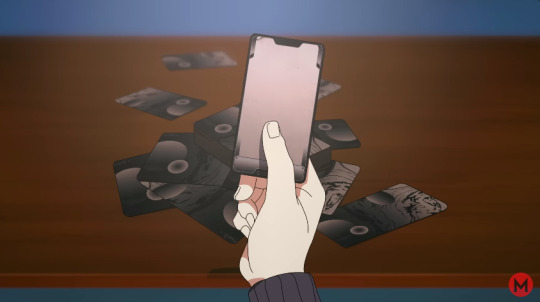

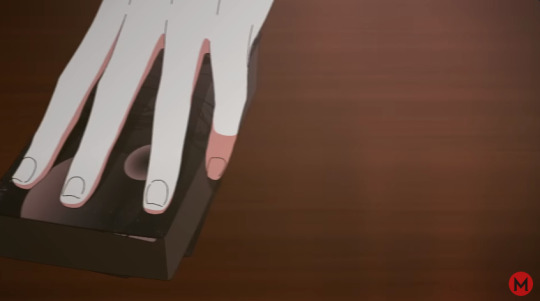
So first, we can be sure this is Aokoto because the lyrics not only use 'boku', but also express confusion at the situation, which only really fits the host.
Why am I [boku] here? It must be a mistake?
Take a good look at me [boku], until you find me
The truth will come to reveal itself
I won't forgive you if this is happening to me even though I'm right
Why am I [boku] here? It must be a mistake?
Take a good look at me [boku], until you find me
(Note: If there is no clarification on which pronoun is used when I put lyrics here, it's because the Japanese doesn't actually use any pronouns)
What's happening here? As stated, the tarot cards are a representation of destiny and their future. By drawing a tarot card, Aokoto is trying to understand his situation and destiny better. And by stacking the deck up neatly, he's trying to take control of his destiny, of his future. The desire to be free and be able to control his life is a very important part of Aokoto's character:
(T1) Q14: What will you be doing in 10 years?
M (Ao): I'd like to work independently and make my own design company. That way I'm free to do what I want.
(T1) Q8: What are your reasons for wanting to work for your current job?
M (Ao): I work at an advertising company that's at the top of the business world, you know? Just being able to get to that position is something to be proud of. I worked really hard to get hired there, too.
Aokoto places high value on the work he's done, because that shows how committed he is to having control over his life and his job.
(T1) Q12: How do you get to work?
M (Ao): I ride a road bike. It's a hobby of mine, and it's good to exercise too. I don't need to worry about missing the train, but that can either be a good or bad thing.
I've seen this answer interpreted a few different ways, but personally I believe what Aokoto's implying is that the freedom of not having to rely on the train is both good and bad. Essentially, he doesn't have to stress about missing it, but there's also no guarantee that he'll get to work in time without the reliability of the train. However, he still prefers the bike, because it gives him more freedom.
... Foreshadowing is a narrative device-
There's also the matter of the tarot spreads which appear in that "blank card" scene. There are two distinct ones:


Now, the whole mess is too complicated to get into here (and I actually am holding off from analysis until we get extra context from Double for that reason), but I believe one of these spreads belongs to Aokoto, and the other belongs to Midokoto (Secret Third gatekeeper alter). Which is which doesn't matter, because the card I want to focus on is the card in the "Hopes and Fears" position (EXTREMELY long story), which is I - The Magician (upright) in both of them. The Magician represents (among a fuckton of other things because tarot cards are frustratingly ambiguous by design) power, potential, basically the ability to achieve your goals. Thus, in the "Hopes and Fears" position, it would mean Aokoto wants to be able to control his life and fulfill his potential, and is afraid he might not be able to.
There is also the "Present" or "Self" card being the reversed XII - The Hanged Man. The Hanged Man upright represents (among other things) patience, the hope that as long as everything continues the same, things will turn out okay. Thus, reversed, it could be read as implying the querent is trying their best to change their situation, but are failing at it.
And this is where we get to the second part of the scenes I pointed out before. Because when Aokoto draws a card by itself, it's a blank card. In other words, no matter how much he wants to, Aokoto doesn't have full control of his future. I mean, obviously, right? He himself can't control his destiny when the other alters are also doing pretty impactful stuff. Depending on what theories you subscribe to, he may have ended up in Milgram without even murdering anyone, which is what I believe.
The same can be seen when he tries to put the deck back together. You might notice the deck there is actually thinner than the other time we see it.


He tries to "fix" or "arrange" his future, but he's "playing with half a deck", he's only half in control of his future. In this metaphor, the other alter(s) would have the rest of the deck, would control the rest of the system's destiny. Does that make sense?
Which gets us to the other alter who does tarot reading.

Notice the red mannequin there? The way 0 - The Fool's pouch of food is now a skull? And you can see this alter, heavily implied to be Orekoto, reads a Celtic cross spread with the Fool in the "querent" or "present" position.
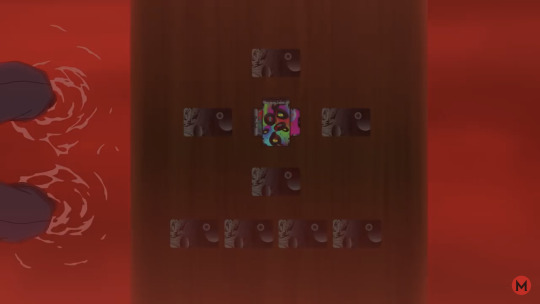
Thus, The Fool represents Orekoto, and he too desires control over their future. That's why he's reading the spread, the same way Aokoto previously tried to draw a card to check his future. And I think it's pretty safe to say Orekoto must have killed or attacked at least one person, which is his way of trying to secure a better future for the system. Protector alter and all that.
[Timelines]
Mikoto (Ao): Can you hear me talking like this? If you can hear me, then answer me. Why are you doing such horrible things? Hey. It's your fault things have become like this. ……Answer me!!
Mikoto (Ore): Ah, ahhh!! Because, I did it for my/your (Boku's) sake…! Because I/you (Boku-ga) would break apart!!
(Translation by Maristelina)
Plus all the other reasons to believe that.
That spread is a bit odd for many reasons, but one thing we can pretty much be sure of is Orekoto's "Hopes and Fears" are represented by VII - The Chariot.
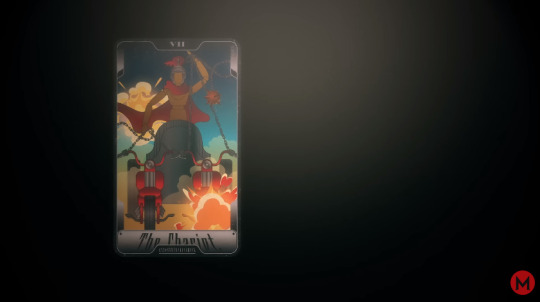
The Chariot (among other things) represents strength of will and control, basically think of it as a more forceful version of The Magician. Thus, Orekoto also hopes he can take control of their life, though he does it through force, and he fears he might be getting too forceful.
If I could laugh, if I could go back
I'd play dead even though I'm alive right?
If I could end, if I could stop
How long would this dream go on?
Assuming it is Orekoto singing here (no pronouns so), it seems he doesn't want to kill, but sees himself cornered, like he has to kill. If he could stop, he'd "go back and play dead even while alive", he wouldn't kill anymore. But when he feels "boku will fall apart", he tries to save him through any means he can, which is likely murder. The exact reasons are as of yet unknown (someone stalking them, stress, could be a lot of things), but that's the idea.
However, you tarot enthusiast might notice a few interesting differences between this Chariot card and the actual Chariot card. This is important, because the meaning of these cards comes from the images, so when the image differs (apart from stylistic choices obvs), the meaning differs with it.

First important difference: the real Chariot has lions, MeMe's Chariot has bikes. This again relates bikes to the idea of freedom and one's own will.
Foreshadowing is-
Second; MeMe's Chariot has the protagonist swinging around a mace, which the real Chariot just has a wand. I frankly don't think this means anything other than MeMe's Chariot explicitly references murder rather than other, non-physical forms of strength and force.
Third, an important part of the real Chariot is that the man doesn't hold a leash on the lions, he controls them through force of will, apparently. Meanwhile, the mannequin in MeMe's version does hold chains to control the bikes, which again I believe simply implies a more forceful and direct version of the meaning. Orekoto doesn't trust his destiny to guide the system in the right direction as long as they're strong enough, he feels he needs to have more direct control.
And finally, the lions in the real Chariot are fine, but in MeMe's version, one of the bikes is fucking exploding.
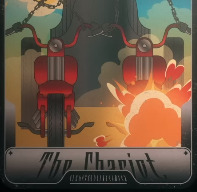
So what the hell is up with that? Well, let's keep in mind what I said before. Aokoto also wants control of his life. So I believe in a way these bikes represent Aokoto and Orekoto's actions. One of them Orekoto has direct control over (he controls his own actions, after all), while the other is getting hurt by Orekoto's control. Orekoto may want nothing more than to protect the system, but the way he does it is harmful to Aokoto and destroys the control he wants to have over their life. I mean, it landed them in Milgram (according to some interpretations), and it's not like Aokoto likes the murder.
(T1) Q6: Tell us what you hate.
M (Ao): Staying up all night working / reptiles / violence
[Double Preview]
Hey now, I [ore] saved you right?
So why in the hell are you crying?
(I will use the preview as evidence, watch me)
Temporary CW for abusive relationships and rape (Mono Poisoner)
This idea of "love" that hurts the other is also implied by Mono Poisoner, their Trial 1 cover. Though to be clear, Orekoto is not anywhere near as awful as the protagonist of Mono Poisoner, since he isn't intentionally hurting the rest of the system, and obviously isn't actually abusing the other alter(s).
“She belongs completely, entirely to me!”
Kissing, sleeping together, everything beyond that too
No one can hope to cut this connection between us
After brandishing that poisonous desire to monopolize and having erased YOU completely,
It seems like it can be easily embraced, the entirety of that heart
“YOU best not get carried away!”
Taking out the really violent and abusive elements out, this does vaguely fit the idea I'm trying to get across.
Temporary CW over
Anyways, the point is that Orekoto wants control over their life, but is accidentally harming Aokoto by taking away his agency.
There is more symbolism of this ‘drive to control destiny’ in the moon which consistently appears throughout MeMe.


As you can see, it’s in the first quarter phase. This is halfway between the New Moon which represents the beginning of a journey and the Full Moon which represents the end or rebirth, and because of that, it can represent a difficult time where decisions must be made, a point where strength of will is necessary. This again fits both of Aokoto and Orekoto, since they’re both making important decisions for their future. Hence also why the moon is half and half, the future is being decided half by Aokoto, half by Orekoto.
Alternatively, you could read it as only Orekoto making decisions, with the other 'half' being "left in the dark" because Aokoto doesn't know what Ore's doing. That would explain why the moon only shows up in relation to Orekoto in the internal world and the murder scenes.
Heavy speculation incoming (more than before anyways)
But hold on a second. I said before the upright Hanged Man, the card on Mikoto's shirt through most of MeMe, is about patience and not doing anything to change their situation. This is somewhat contradictory to The Fool, which is all about new opportunities and taking new risks (long story), and is obviously contradictory to the reversed Hanged Man because that's how tarot cards work. Because of that, and everything else I've been saying, it feels like the upright Hanged Man doesn't really fit either Aokoto or Orekoto.
Which is why it's so convenient we have a third (plot-relevant, there may be more) alter who does want their life to continue as is, isn't it?
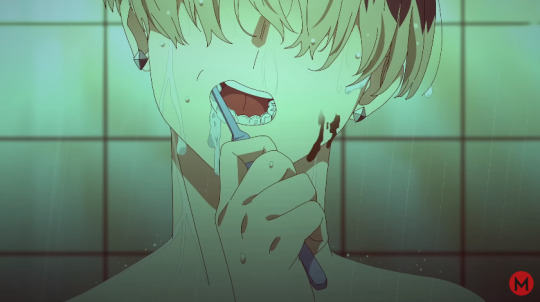
The minus energy that I swallowed
Hugged me [boku]
Maybe it's okay to try to keep on living
Split in half,
Make that heart beat
This scene is very clearly connected to the aftermath of a murder, and shows an alter that has accepted the "negative (minus) energy" of violence. However, the use of 'boku' rules out Orekoto as the singer. Thus, we have ourselves our favorite Secret Third Alter, Midokoto. And Midokoto says, filling in the blanks, that ‘maybe it’s okay to keep living [like this]’, as long as they ‘split in half’ to ‘make that heart beat.’
Before we continue, I have to address that yes, I believe Midokoto is represented by the upright Hanged Man, even though he’s the only alter who’s never seen wearing the shirt. Either his back is turned, he’s shirtless, or straight up has a completely different shirt. However, I actually think this makes perfect sense.
It’s widely accepted that if Midokoto exists, he’s likely a gatekeeper alter who co-fronts most of the time, meaning he’s still aware of everything that’s happening even while he isn’t controlling the body (<- simplified version, read more if you’re interested [alter roles] [co-fronting]). Therefore, he’s a constant in Mikoto’s life, and it makes sense for him to always be present in some way as long as any alter is on screen. He’s on the shirt when the other two are there, so when the shirt isn’t there, it’s because the ‘upright Hanged Man’ is the one controlling the body. Does that make sense?
I should note, Mikoto’s version of The Hanged Man includes a bunch of eyes on the background.
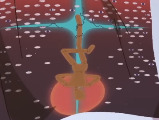
Which fits the idea of Midokoto overseeing everything in the others’ lives, and for the inverse in Aokoto’s case could also be interpreted as societal pressure, long story.
Yes, Midokoto's celtic cross spread has the reversed Hanged Man in the middle of The Wheel, but let’s just say that means ‘present’ rather than ‘querent.’ Yes, there’s a Fool portrait in the background of that one scene, I swear there’s an explanation but it’s too long to get into here.
Point is, he’s the one who wants their life to continue as is, and thus the one who fits the idea of ‘patience’ that The Hanged Man (upright) embodies.
But make no mistake. He still has The Magician as his “Hopes and Fears” in the spread which represents him, meaning he does yearn for some control and fears not having the means to achieve it.
However, I believe the type of control he’s looking for is different from the other two. See, while Aokoto wants freedom and control over his life in a more conventional way (good job, free movement, independence), and Orekoto wants control in a ‘no one will stop “I/you” from achieving what “I/you” want’ kinda way (aka safety), Midokoto wants control over the system, not the rest of their life. He wants to keep Aokoto and Orekoto ‘split in half’ because that’s how they can both live as they please, it ‘makes their heart beat.’
That’s why the moon that represents decision-making is split in half. That’s why there’s only two bikes in The Chariot card. That’s why Midokoto never bothers to read a single tarot card. Because the ones deciding where their life moves are Aokoto and Orekoto, all Midokoto does is keep things running smoothly. Though of course, this is all just my interpretation.
In fact, you can even tell based on what we believe each alter to do. Aokoto does the day-to-day work, making sure he has the opportunity to achieve his dream of working independently in the future. Orekoto deals with threats until the system as a whole is safe, which includes throwing away evidence so they don't get arrested. He does a dogshit job at it, yeah, but he's trying.
However, once they get into the apartment, when the external threats have been dealt with, the one who bathes to make sure Aokoto doesn't learn of Orekoto's actions, the one who keeps their lives metaphorically 'split in half', is Midokoto.
Heavy speculation kinda over
So, where were we? I said this was inspired by the Double thumbnail, didn’t I? Well, yes, even if I have very little to say about it in relation to this post. You could say I kinda, uh, went off the rails a bit (<- I am immensely unfunny)

As I said, he’s on a train. And with all the stuff I mentioned before about how bikes are associated with freedom for him and stuff, it makes the imagery of being stuck on a train with the victims (I assume that’s what the mannequins represent, I’ve seen other interpretations) a lot more interesting.
Think about it. When you get on a train, you made the decision to enter it, but you don’t have control over where it goes. And that’s what’s happening here: the alter on screen is in for the ride, and he feels there’s nothing he can do to alter the course. It’s like a railroad.
Aokoto didn’t get on this train. Obviously the scene is metaphorical (otherwise who left their mannequins in the goddamn public train), but we know Aokoto doesn’t use the train. However, he’s on it now, alongside Orekoto who is probably the one fronting here? I assume, given the red light in the background. In my mind it would make sense for the thumbnails to be Aokoto T1 -> Orekoto T2 -> Midokoto T3, but that doesn’t have to be the case.
What I’m trying to convey is the symbolism of the system being stuck in a set path, a set destiny, caused by a decision not made by Aokoto. And if Orekoto is really the one fronting or being represented here, he’s miserable because of the path his actions have landed him on.
If I could break it, if I could change
Can I do it, I wonder from when I started to give up
He’s ‘given up’ because he’s accepted he’s ‘on the train’, his path is already set and he can’t change it (“if I could change”). Yes, give me that Orekoto angst!
Anyways, please keep in mind this is all my interpretation of the symbolism and all of this is extremely subjective, especially with how confusing Mikoto's entire story is. I hope you forgive my brainrot at seeing a guy take a train. Take care!
85 notes
·
View notes
Text
Defending Mikoto online isn’t enough, I need a bat
#milgram#esp the theories that still think he somehow faked DID#despite being confirmed by Jackalope twice#and how it would be more harmful if he did fake it#also Akakoto is shown in the voice drama to front when Aokoto is threatened
39 notes
·
View notes
Text
youtube
Watch the 2024 American Climate Leadership Awards for High School Students now: https://youtu.be/5C-bb9PoRLc
The recording is now available on ecoAmerica's YouTube channel for viewers to be inspired by student climate leaders! Join Aishah-Nyeta Brown & Jerome Foster II and be inspired by student climate leaders as we recognize the High School Student finalists. Watch now to find out which student received the $25,000 grand prize and top recognition!
#ACLA24#ACLA24HighSchoolStudents#youtube#youtube video#climate leaders#climate solutions#climate action#climate and environment#climate#climate change#climate and health#climate blog#climate justice#climate news#weather and climate#environmental news#environment#environmental awareness#environment and health#environmental#environmental issues#environmental education#environmental justice#environmental protection#environmental health#high school students#high school#youth#youth of america#school
18K notes
·
View notes
Note
Hello! If it’s okay, I’d like to know your thoughts on the Trikoto theory (3+ alters). I think it’s a cool theory! And pretty likely, honestly. (Here’s a document about it in case you don’t know what I’m talking about. I didn’t make it, and I unfortunately don’t know who did, I just found it in another blog)(I really hope that link works lol)
Hey FF! I was wondering when you might send something in. Not the topic I expected, but I'm here for it!
I've definitely heard of this theory before. I can't say I know for sure where it originated, but I've always been under the impression that a blog called @bertrandcaillet started it as they're the first one I saw talk about that theory and they told me about it a while ago. They've since deactivated, though, so I can't really check with them to see if that's true.
I think the trikoto theory is interesting, and I fully agree with what's said on the document about how it would be nice if Milgram is showing a system with more nuance than just having two alters.
That being said, I personally don't believe this theory for a number of reasons. I'm going to do my best to explain why here. I do want to say going into this that while I do have extremely minimal psychology teaching (as in, undergrad psyc MINOR), I do not claim to be that educated on DID or similar struggles. So, anything that I say will be focusing much more on Milgram as a piece of media from a writing standpoint, because that's what I have much more extensive experience in.
I will say that I am very aware that most systems have more than 2 alters. That being said, I think I also remember from my psyc class that the average number is, like... 16? I'm not at my dorm right now and that's where my notes are, so I can't check, but I remember specifically thinking about it in the context of Mikoto and trikoto theory, so I'm pretty confident it's Above Three. That means that either way, it's not like we're doing The Most Common Number, so I think two versus three is largely irrelevant on that point.
For the sake of clarity, I'll be using the names in the doc (Akakoto, Midokoto, Aokoto), but I only personally believe that two of them (Akakoto, Aokoto) exist. I've taken to calling them Orekoto and Bokuto, but for this post, Akakoto and Aokoto it is.
At its base, my problem with trikoto theory is that I don't see a lot of evidence for it. Most of what I've seen has been talking about the implications of it if you assume it's true, but I've just never really been convinced in the first place. I'll just go through some of the main reasonings real quick:
The RGB Colors
I do acknowledge that I'm very much not a visually oriented person, so the color shifting is something I'm less inclined to notice. However, while the background of the room is blue and the train station and apartment are pretty green, I don't feel like there are ever really any red backgrounds (other than when the headspace becomes red as ooposed to blue). Because of that, I have a hard time believing that the backgrounds themselves contribute to the idea that there are three. I definitely think the red/blue coloration in the eyes and such are indicating different alters, but I don't think that specific fact supports there being three of them.
The Voice Changes
This might be a me issue, but I only really hear two different vocal inflections. I understand the point about there being some harsher (?) sounding vocals that don't have the growl, but personally, I still think the tone matches the one described as Akakoto enough to count. Similarly, the parts towards the end that are picked out for Midokoto ("I'm probably not to blame," etc.) actually sound more like Aokoto to me even if I do try to track the three voices.
I'm hesitant to go too hard in believing the different voices because to me, doing so would severely limit the amount of control Natsuki Hanae would have over the emotions he wants to put into the song. The vocalists in Milgram do a fantastic job at using specific vocal intonations to convey deep layers of emotions in their songs. I feel like it would be very limiting to only be able to use certain vocal effects (ex. growl) in specific places due to the limitations of the characters. If there are two, the two voices are far more separate, which gives more space for customization within the bounds of each voice.
This is also a little bit iffier on evidence, but there's the Es cover of MeMe. I don't know how much Yurina Amami knows about Mikoto's story and the entire video is in grayscale, so take all of this with a grain of salt, but to me, I feel like Es uses two voices here, not three. Notably, they even have a bit of vocal growl on the "switch" and on "split and half, make that heart beat," which are both squarely in the Midokoto tone. They do still have the two voice split, sounding a bit more apathetic and aggressive in the Akakoto parts and cuter in the Aokoto parts. To me, that signifies that there's suppose to be two voices going on, not three, but you could argue that that's just Es' perception of Mikoto, so it's not decisive or anything.
Mikoto Fighting Es
Yes, in his first audio drama, Mikoto is able to beat Es up until Kotoko stops him. Yes, that's inconsistent from what we've seen from Futa and also t2 Amane. I agree that that's because the Milgram rules only apply to one or more alters, and thus any others that may exist can get around the rulings. We saw this between trials, too, with how Mikoto (seemingly Akakoto at the time) was able to avoid being restrained despite his guilty verdict, likely through the same loophole.
(Side note: this implies to me that Milgram's system for restraining guilty prisoners is, like the protective barrier around Es, somewhat magical and isn't a physical thing. Thus, if we were to, say, vote Amane as guilty, I am fairly confident she would be unable to harm any other prisoners, as we've already seen the barriers are able to prevent her from attacking others. I still lean Amane innocent anyways, but I wanted to point this out.)
Anyways, I don't think that this is actually evidence towards trikoto theory because it works perfectly fine with just the two of them. Aokoto is the prisoner in Milgram and Akakoto isn't. This doesn't necessarily mean that Aokoto is the one who was fronting while the murder happened, though; the rules of Milgram just necessitate that the prisoner is involved in/related to a death. It can be indirect.
I think that that's exactly what Milgram is asking us with Mikoto. The question is, how do you fairly hold a system accountable? Can you blame one alter for the other's actions?
Milgram loves to complicate these, and I can see the appeal of a complication being learning about a third alter. Personally, I think it's much more likely that the route Milgram is taking is looking at how much knowledge the alters have about each other and asking how much Aokoto would have to know to make him an accessory to Akakoto's murder plans. It could go either way, though.
Some Bonus Points
I think the strongest piece of evidence brought up is the use of threes in Mikoto's design. Other than "they just liked it aesthetically," there isn't much of a counterargument I can make about it. My best one would be that they might be going for a "switching between black and white" type of thing, which would work better with more stripes, but that's pretty weak. I also had the idea that the first character of his name looks like three stripes, which might be a better or worse explanation! You get to decide, I have no idea.
The cake sells me less, though. It's true that Kazui's is a perfect 50/50 and that Mikoto's isn't, but that's because they're representing different things.
Kazui's is half and half because his song is called half, and it could also be a sign of how he and his wife didn't actually connect more in a marriage sense; they're still two fully separate people rather than being a unit.
Mikoto, if he has two alters, is still physically one guy. Mikoto is mostly sitting on the flower designs. I'd argue that the flowers are meant to show Mikoto as a whole: the connection point of the two alters.
That's pretty much all of what I have to say on the doc (in terms of the trikoto aspect, whether I believe it or not there's some good work done in character/lyric analysis that applies to two or three alter theories), but I'll go over some of my reason for why I actively believe there to be two, because there are some reasons.
Reason 1: The Song Titles
The doc explains what the meaning of MeMe is in trikoto theory, but it definitely still works with two, more obviously so. That's not evidence, though, because the trikoto theory has a viable explanation too.
I have no idea what they'd be doing with the song title Double, though. I guess it would be a play on somebody being someone else's double, meaning they're someone like them, which is no doubt part of the song title either way, but I think it's difficult to ignore the meaning of Double that means, y'know... multiplied by 2, or:

But that could very easily be a diversion and we haven't seen the second video, so I'd let that slide. However, that brings me to the bigger problem:
Reason 2: Upright Versus Reversed
AKA, the tarot cards.
Tarot cards can be read two ways, Upright or Reversed, based on the orientation of the card when it's placed/picked up/whatever. I already went over in my original theory (which is pretty outdated, I could do a way better job but I wrote that one literally first out of my milgram thoeries and I hated not having a good name scheme for the various alters) why I believe Akakoto to be the Hanged Man (Upright) and why I believe Aokoto to be the Hanged Man (Reversed).
I struggle to imagine why the devs would pick tarot, something that clearly has two meanings to it, when there are actually three alters. Maybe it'd just be to throw us off the scent, but it feels a bit too intentional to me.
Plus, if it was meant to throw us off, I'd expect we'd get a different metaphor/symbol for the second MV (as we have been with pretty much everyone). However, the association between Mikoto and "reversible" things has continued into trial 2, even before his MV has come up.
I say this because of his trial 2 cover song: Reversible Campaign. Funnily enough, I actually thought this song would go to Kazui before it was announced as Mikoto's, but then I looked again and understood why they wanted it for Mikoto.
My thoughts get confused and fight with each other
Very Mikoto, works for either two or three alter theories. However:
I just want to waver between black and white
It's turned me upside down
There's more that seems to paint Mikoto's mind as a dichotomy, not a... trichotomy? Is that a word? I don't actually know.
The Song Lyrics of MeMe
This is sort of an extension of the above part, but there are also definitely song lyrics in MeMe that sound like they're heavily implying two. Again, you could argue that that's trying to throw us off the scent, but some of them are, in my opinion, actively difficult to justify for trikoto theory.
Split in half, Make that heart beat
I cannot for the life of me understand why any of the three alters would say "split in half" if there are three. I guess if any of them were aware of one of the other alters, but not the other? I don't think that's what was being argued, though, sorry if I missed that.
I’m already the fake one
Little harder to argue this one because I don't know how definite versus indefinite articles work in Japanese, but saying the fake one really sounds to me like there is one fake and one real. If you were just having a moment of existential crisis, in most situations, I think you'd opt for "I'm already fake."
The Mirror
This is sort of the same argument as the tarot cards, but there's also the use of mirror imagery in Mikoto's MeMe MV. Mirrors have two sides and are a reflection. You could use Haruka logic and say that it depicts self reflection, I guess, but considering the reflection acts differently, I think it's much more likely that this is meant to show the two alters.
Conclusion
Hopefully this all made sense? I respect trikoto theory and I could easily be super wrong about it (see also: my original opinions on gay Kazui theory and police Kazui theory), but I've just never really been sold. It's possible my opinion would change if I saw evidence that I felt worked better for trikoto than... twokoto? theory, but personally, I feel like most evidence I've seen for it is still better explained by there being two alters. Let me know what you think, though :)
#milgram#ミルグラム#mikoto kayano#milgram theory#admin venus#we talking about mikoto again!#makes sense considering his video's coming up next#MeMe was the first video that i saw the day it came out#so that's kinda exciting for me#also i strongly doubt you're out there anon who asked about mikoto having potential childhood trauma bc DID is VERY heavily related#but if you are i'm sorry i haven't responded i am so no thoughts head empty on what it would be#i suspect there probably is trauma there bc DID is SO frequently connected to childhood abuse but i simply don't have any answers in my min#also hi ff welcome to milgram again :D
59 notes
·
View notes
Note
homestly inknow my math really well personally i got an A sonlike yes but yknownthisbis rrally important since my friend some stupid math conspiracy thing where1+1=3 because she talked about how like if you combined a couple together theyd have a kid so itd sum uo to three which also reminded me of the MeMe theory with trikoto hinting that mido exists like how its portrayed but i forgot who made that theory butbyea whay do you think about 1+1=3 is it correct or just2 bevause the explanation she gave kind ofmade snese’
i think your friend is insane and normally I would leave it like that because im cool like this however today I'm going to be shameless and provide an explanation. what if the couple is gay. what if the couple doesn't wants to have a child. what if the couple is unfertile. so many scenarios. 1+1=2. however if 1+1 wants then 1+1=2+1=3
with kayano system it happened the same thing given that john has split somewhat recently to take the role of the murderer (and yet he's unable to tell us more about this) (and most scenes where murder is happening are green) midokoto and aokoto split john due to a necessity to shift the blame in an attempt to cope with what happened somehow at least this is what I think
27 notes
·
View notes
Text
A Who-Swung-It Mystery: The Case of the Switch-Hitter (2/3)
1 / 2 / 3
Another fun fact before the cut, did you know that the term sinister, meaning evil or lurking danger, comes from the Latin term sinister, meaning of the left side? Its antonym, dexter, means on the right side.
Just the warning one more time: despite the humorous title, I want to be serious for a second. I am not a licensed psychologist/psychiatrist/licensed social worker/etc., and I am certainly not an expert on dissociative identity disorder (DID). My knowledge of this disorder comes from the research I have done to try and understand it. I am trying to be as respectful as possible towards the subject matter, and I sincerely apologize if I show a lack of understanding and will do my best to correct it. Any mention of DID is more focused on switching since we haven't got a clue as to how Mikoto developed DID, and the how isn't really important to the murder itself.
Again, I apologize for the length. Building a case against Mikoto has been a proper pain in my ass because of the constant misdirection from John. If you missed it, I argued that based on the behavior shown by Mikoto and John, I believe that Mikoto is the killer and John is attempting to shield him by taking full responsibility. John's acts of erasing what Mikoto has done led him to believe that his murder of the blond, young man seen in MeMe was just a bad dream. I also drew a connection between Mikoto and John and Dr. Jekyll and Mr. Hyde. I just find it fascinating that John is depicted as the Hyde to Mikoto's Jekyll, but instead of wreaking destruction, John provides Mikoto with protection by playing into the evil alter trope and claiming he had been the one to kill. I also talked about switch-hitting and why batting left, despite being naturally right-handed, is something Mikoto would do, not John.
If you'd like to start violently shaking me again, feel free!
One or Two: How Many Alters are There?
Ultimately, my theory hinges on the belief that it is just Mikoto and John. Initially, I believed that there was only Mikoto and another personality (the dual personalities, collectively called Bokuto and Orekoto until Neoplasm). Then, after seeing some really good Trikoto arguments (Aokoto, Akakoto, Midorikoto) that justified it with the existence of a third personality, I started believing it too. Now, I'm hearing that Yamanaka debunked the Trikoto theories when Double was first released, I'm back to thinking that there are just two personalities: Mikoto and John. Although, I would not be upset if Trikoto was right. Those were some really thorough arguments using lighting, and I ended up looking back at the use of lighting when I was analyzing MeMe.
A huge part of the Trikoto arguments were the use of blue, red, and green lighting throughout MeMe. That is when I noticed something about the red light. While red light overwhelms the mental mindscape whenever John appears, the use of red light in the physical world is rather minimal and only used twice. Both times that it is used the physical world, it involves the victim's point of view (the left-handed swing and the implied burial), and the red light is a small amount reflected off of Mikoto's eyes.
MeMe's Use of the Mental and Physical World
In MeMe, we can very clearly see the difference between the physical world and Mikoto's mindscape. There are no moving parts to it, and it is isolated to one location. His mindscape is combines the layout of his studio apartment (we can see his couch, coffee table, and TV stand) with the crumbling tile walls that seem to come from his bathroom. The physical world in MeMe depicts various locations, starting with the scene of the crime and ending inside of Mikoto's apartment. We are also shown two scenes where John gets rid of evidence by burying the body (implied by the dirt being tossed over the camera) and throwing out the bloodied clothing in the dumpster (explicitly shown).
The physical world scenes use green-blue tints, and I found that the use of more green lighting than blue or vice versa is subjective to a viewer's definition of which color is more dominant and it is inconsistent, making it difficult to tell who is fronting. Personally, I think it is used to help misdirect the audience because the color of the lighting and the behavior of Mikoto and John are inconsistent.
The mindscape does not have this problem. Not only does it have a stark division between Mikoto and John by using the peaceful blue water to represent Mikoto and the stained water/red blood to represent John, but it also has blue mindscape Mikoto and red mindscape John behave how we expect them to (Mikoto is confused and pleading while John is mocking and menacing). It's pretty clear that the image Yamanaka wanted when we think of John is red = aggression. Perhaps the overkill of red light in the mindscape is to make it clear that John is now fronting and in control, while the minimal use of in the physical world is to highlight how hidden DID can be or how switching can be ignored or written off. In addition to the lighting, I would like you to also take a look at the use of eyes, tarot cards, and right-left dichotomy in MeMe.
At the very beginning of MeMe, there is a red haze over the mindscape and we see who we can presume to be John pick up the camera and smile at the audience. Then it cuts to the two large tarot cards of the Hanged Man (reversed) overlapping the Fool (upright) in the blue mindscape. The reversed Hanged Man is on the right while the upright Fool is on the left. From what I can tell, a reversed Hanged Man seems to mean that a person feels as though they are sacrificing a lot without getting much in return or it is not turning out the way one would expect it should. Knowing what we know about Mikoto's workplace, this might be referring his boss overworking him with unrealistic expectations. It overlaps the upright Fool card, which usually represents new beginnings. This could refer to John's 'birth' but I think it probably represents Mikoto being hired at his company. The stress from the overwhelming work load now overshadows this amazing new opportunity.

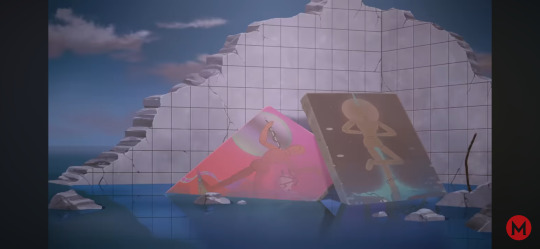
We cut to the train tracks to witness the part of the meeting and murder of the blond man. If you look at the area, it’s secluded and dark. It’s not a place where you just take a stroll. Mikoto is waiting for someone. There is no bat, and it looks like Mikoto is loosely holding his phone in his hand. We cannot make out his expression, much less see his eyes. Then we jump forward to the victim’s point of view to see Mikoto ready himself for a left-handed swing. His arms make it hard to see his expression, but we can make out his left eye, which is reflecting red light. During the right-handed overhead swing, implied to be the kill swing, we cannot see Mikoto’s eyes. And, I didn't realize this when I first watched MeMe and Double, but MeMe actually does pose the idea that Mikoto seems to believe that he dreamed of killing a person, something Double insists on. The lyrics during the murder shown in MeMe ask, “How long would this dream go on?”


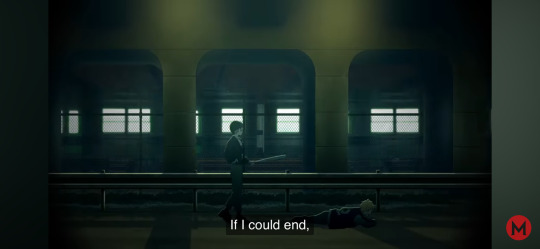


When Mikoto returns to his apartment, Yamanaka avoids showing us his eyes at first. After taking off his shirt, it looks as though Mikoto is looking back at the audience, but his hair is blocking most of his right eye. We then cut to him on the couch for the "Switch / Shake up that brain" line where we can see his left eye but his bangs hide his right eye completely. Then, we are first transported to the blue, clean water mindscape where his right eye is the one that opens. I think this is the early evidence that we are meant to associate Mikoto with his right side and John with his left, because there is so much left and right action going on in both songs that I'm getting a headache. Back to the couch, Mikoto reaches for a tarot card, and the mindscape world turns dark and has a laid out array of tarot cards overlaid his stacked deck where Mikoto first picks the Devil (upright) tarot card. The upright Devil tarot card usually signifies depression, addiction, or despondency. This could be the stress from being overwhelmed with work. It is supported by the glitchy cut following this, where we see Mikoto come into his apartment late at night and break down into tears.
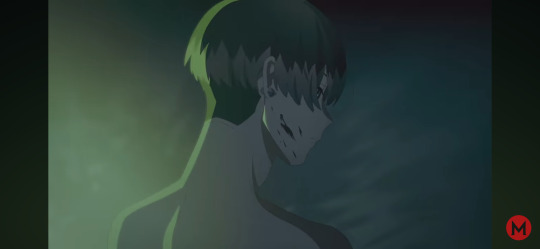

Again, we cannot see Mikoto's eyes when he disposes of the trash bag and his bloody beanie or when he brushes his teeth (right side of his mouth, actually) while his left cheek is splattered with blood. We have more focus on the left-right split where Mikoto has his left hand beside the bathroom mirror as John looks on in concern. And then we see Mikoto's right (and visibly covered by his sweater sleeve) hand rest beside the mirror as John gives the creepy, menacing smile. Mikoto reels backwards and the Devil tarot card falls into his lap. Coincidentally, John doesn’t appear in the mindscape again until the Devil tarot card falls a second time and hits the water of the mindscape, turning it blood red. It almost seems accidental, with Mikoto watching the tarot card fall to the ground in horror. John stands behind him menacingly, but his eyes are hidden. We don’t yet know his intentions, but with the menacing red light, we are led to believe that they are bad. The Devil tarot card being repeated three times could signal Trikoto, but I think this may just be to establish John's existence before Mikoto got his current job. He has been there, watching Mikoto with concern (first mirror appearance), and then John was proud of being able to intervene with something that had happened, possibly creating the blackmail material (hence the proud smile in his second mirror appearance). Neither mirror appearance is directly preceded by a Devil tarot card. The second mirror appearance actually comes before the tarot card. I could see the mirror appearances predating the Devil tarot card as a sign that John attempts at helping Mikoto relieve his stress only made things worse, leading directly to the murder.
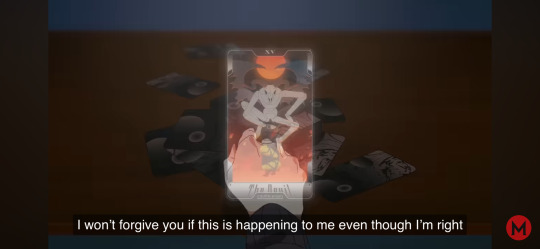



After we see John in the mirror a second time, Mikoto seems to stumble backwards before he falls while the lines, "Why am I here? / It must be a mistake? / Take a good look at me / Until you find me" plays. I would argue that this is when Mikoto meets with his victim. They're two adults meant to talk things out. This is just a mistake that can be cleared up. This is when we see the Devil tarot card-for the second time overall-fall into his lap. The victim lays out his blackmail threat. Mikoto is despondent, and when he picks up the card, the image burns away. The lyrics played are, "The truth will come to reveal itself / I will NEVER forgive you if this is happening to me even though I'm right" and I think this is when the seriousness of the situation hits. The mindscape is still blue as Mikoto sings, "All those ridiculous accusations" and then when the Devil tarot card falls to the ground, the mindscape glitches from blue to red to blue to red for "Hurting it / Holding it down". Now, this could be a sign of Mikoto starting the murder (at minimum, he delivers the first, left-handed swing of the bat) and John ends it by disposing of the evidence. Who delivered the second, deadly swing can be debated. I lean towards Mikoto delivering the deadly blow, and I will get to it in a minute.
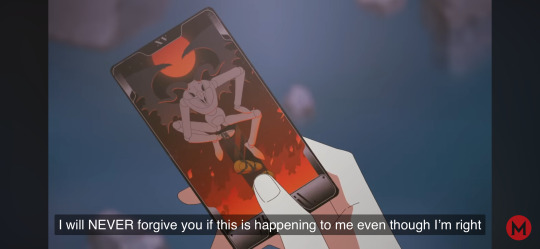


This third appearance of the Devil tarot card directly precedes John's appearance in the mindscape, implying that John took over during some immensely triggering event. Based on how Mikoto seems to be frozen with horror during this time, I think this was when Mikoto realized that he had killed someone (hence the "My life... it wasn't supposed to be this way," glitched line from the first voice trailer. He cannot comprehend what he had just done, and John took over to dispose of the evidence, so Mikoto can just disregard this as a dream. Because Mikoto and John are both present for, "It doesn't change anything, does it / It's the same anywhere I go / It's like what's wrong isn't wrong / I'm already the fake one" it is hard to tell who is singing, but the self-pitying language makes me think of Mikoto, not John. Mikoto just wants to go along and get along but everyone around him insists on making trouble. First the victim threatening to get him fired, then Es insisting that his little dream was reality, and then Kotoko attacking him.




I think that when the mindscape turns red a second time, it is supposed to represent the switch during John Doe. Mikoto is pleading for Es to answer him and truly see his reality, “Why am I here? / It must be a mistake, right? / Take a good look at me / Until you find me,” and then he snaps, briefly turning the mindscape red on an overhead view. It’s almost as if the switching is done on purpose. From what I've read, forcing alters to switch can happen, but it is not advised because of the potential repercussions within the system. More than likely, Mikoto snapping before switching with John symbolizes Mikoto facing another trigger, this time the reality that his dream of killing someone wasn't a dream, and then John taking over to protect that belief. But it’s John’s behavior and the lyrics that we see while the mindscape turns red again that I want to focus on: “Hey why, / I’m nowhere to be found / So / I will NEVER forgive you if this is happening to me even though I’m right”

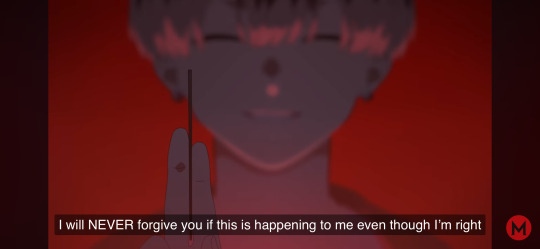

John is taking Mikoto's words and actions as his own. He takes the passive aggressive remark of Mikoto's refusal to forgive and makes it a clear threat and draws the tarot card. He doesn't do it the same way, though, because this time he clearly shows off the tarot card rather than letting us look over his shoulder. John has his eyes closed, upturned to match his smile, and then they open as his expression turns cold. While his eyes are closed, we see the back of the tarot card, and when they open, he turns the card so we can see it. It’s the Fool tarot card, which again, generally signifies new beginnings. We flash to more tarot cards lying on the table before John pulls out the Death (upright) tarot card and then John moves to punch the camera. As many people have already stated, the Death tarot card doesn't mean actual death, and usually signifies a major change has already come, is currently happening, or will come soon. With the Fool and Death tarot cards combined, John is making it clear that his role as Mikoto' protector is now going to become proactive as he plays up the idea that he is the uncontrollable, evil Hyde to Mikoto's even-keeled and good Jekyll.
I'll admit that this theory of mine has its weaknesses. Primarily, it's the stupid blood splatter on Mikoto's face while he is in the physical world. When he strips off his bloodied clothing, there is a blood splatter on his right cheek, but when he buries the victim, the blood splatter is now on his left cheek, not his right. In the shower while he brushes his teeth, the blood splatter is on his left cheek. That pokes a hole in my only one victim theory. There is a chance that since the blood stain on his right cheek is very close to where his jawline and ear meet that the clod of dirt and the angle we see Mikoto at hide it during the burial scene. Just like how there's a chance that John took more care to make sure Mikoto's right side was clean since Mikoto is associated with the right side and John with the left. It is a weak defense. I can admit to that. But I hope I've provided enough evidence to help support my argument. Maybe that right cheek bloodstain is related to the blackmail material.



Why I think that it's John disposing of the evidence... it's like how I said it in the last post; while John is trying to be more proactive by taking the blame for everything to protect Mikoto, John is more reactive and less careful than Mikoto. In John Doe, John literally beats the shit out of Es, someone who holds the fate of Mikoto in the palm of their hand. Most people would not antagonize and threaten someone with that kind of power. John is short-sighted, and until he's restrained and forced to think and plan during Neoplasm, John's pretty terrible at actually helping Mikoto. Yes, we see him bury what we can presume to be the victim, but we don't know what happened to the murder weapon (the baseball bat that should be covered in blood and dents) and the bloody beanie was not stuffed inside the garbage bag before being tossed into the dumpster. The dumpster isn't very tall. Anyone could look in and see the blood-stained beanie. Despite showering to get rid of the blood on him, Mikoto clearly strolls into his apartment covered in blood splatters. Anyone could have seen him. Yes, he technically took care of ridding the blood evidence off himself, but John doesn't seem to have taken any precautions, like maybe turning his clothes inside out to try to hide the bloodstains. Mikoto is someone with a five-year-plan and takes the safer options in life to avoid messing it up. John wings it. And sure, it is very hard to prosecute someone for murder if you don't have a body, but I won't lie, I can easily see John deciding to bury the victim and murder weapon together so he can decrease the amount of time he has to spend at the crime scene. I know that it's not in the garbage bag, because you'd see an oblong object distorting the bag's round shape.
Now, why a dream? Well, the idea of losing his dream job and tanking his career before it even started is probably the scariest nightmare Mikoto could ever have. Denial is his modus operandi. He probably went to the tracks to meet his victim to try and talk things out like two proper adults should. John would have come out swinging as soon as he saw the blond. Mikoto, on the other hand, thinks this is just a mistake that can be talked out. When he sees the blackmail material, he believes it's too ridiculous lie, because how could he, the calm, kind Mikoto take pleasure in hurting someone? This can't be real. It has to be a dream, and in dreams, there are no consequences. And so he loses his temper and strikes. When the red haze of his temper lifts, he realizes what he has done and breaks. John takes over to spare him from this immense pain. He gets rid of any evidence (not well, but still) so Mikoto can wake up in the morning and sincerely believe that all he did was have a bad dream. A nightmare he just can't quite fully shake, if you want to look at the lyrics during the murder: "If I could go back / I'd play dead even though I'm alive right? / If I could end / If I could stop / How long would this dream go on?"
1 / 2 / 3
#mikoto kayano#john kayano#milgram#who-swung-it#i am too proud of that pun#I wanted to add more screenshots#but I can only add 30 pictures or links
19 notes
·
View notes
Text
hiii as the person who apparently introduced RGBkoto theory into the english-speaking milgram community i need to make some things clear about the details of it
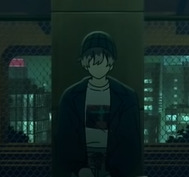

assuming that mikoto's alters do indeed stick to using one first person pronoun for the sake of narrative clarity, this guy is simply not orekoto and cannot be orekoto. this is not the guy who's been fronting occasionally in prison; this is not the guy who attacked es.
the way MeMe is structured in both video and song indicates that there are two main characters within it. it focuses primarily on the guy in the pictures above, who's been nicknamed red/redkoto/akakoto/etc. by the community, and the current host, who's been nicknamed blue/bluekoto/aokoto/etc.
now, visually, MeMe implies through symbolism that there are three mikotos within the first thirty seconds of the video.
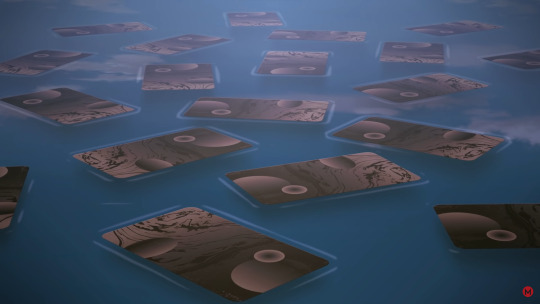
the backs of the cards have three circles on them. a big one with a little one right next to it, and a medium-sized one farther away.

the next shot is a closeup of the big and little circle. "these are the main characters we'll be focusing on in this video." (additionally, this implies that blue split from red.) the layout of their home and headspace has imagery similar to the tarot cards, what with the couch with two seats in the middle and the one chair in the corner.
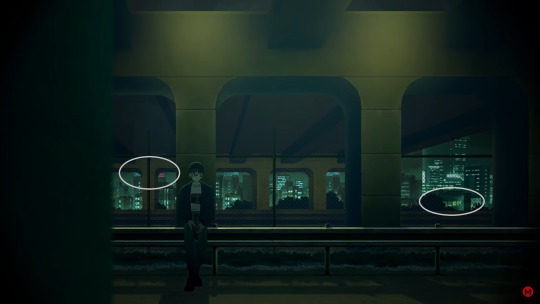
here, you can see in the background that there's a building with a blue half and red half, and farther away, there's a building with green-- greener than the other buildings-- lighting going on inside.
now, since our two main characters in the video are red and blue, we can assume that this is also the case in the song itself. and like with the visual imagery, there's a third voice in the background-- those death growls during the metal sections.
now, let's assume that the switching of genre in the song represents switching itself. what first person pronouns are used in those parts? it's still just boku! if red is a boku user, then by process of elimination, orekoto has to be green.
38 notes
·
View notes
Text
youtube
Watch the American Climate Leadership Awards 2024 now: https://youtu.be/bWiW4Rp8vF0?feature=shared
The American Climate Leadership Awards 2024 broadcast recording is now available on ecoAmerica's YouTube channel for viewers to be inspired by active climate leaders. Watch to find out which finalist received the $50,000 grand prize! Hosted by Vanessa Hauc and featuring Bill McKibben and Katharine Hayhoe!
#ACLA24#ACLA24Leaders#youtube#youtube video#climate leaders#climate solutions#climate action#climate and environment#climate#climate change#climate and health#climate blog#climate justice#climate news#weather and climate#environmental news#environment#environmental awareness#environment and health#environmental#environmental issues#environmental justice#environment protection#environmental health#Youtube
17K notes
·
View notes
Text
Mikoto Trikoto Theory Thread

Why do some ppl still think there are 3 personalities? Even songs' names are "MeMe" and "Double" which represents "two", plus there were only two people standing in that mental world..
I think this is a very valid question! And thus, I present an analysis.
How can you be sure that it's the same Mikoto alter that appears on the same shot instead of another Mikoto? They practically look the same!
Double doesn't have to mean 2. It's either, there's two of you (1+1) or there's another set of two (1+2). Japan is also known for a lot of word play. Language is also very complicated if left ambiguous.
Let's check the NEW lyrics for Undercover.

Me, Me, I (2+1). It's important to know, Me, Me and I are all capitalized. Symbolizing different people. It's also theorized that they are not aware of the 3rd personality (color green).
An important thing to remember, Green colored things are called Blue in Japanese. Considering we have "Aokoto" and "Mido(ri)Koto" (Red Green Blue), it's possible for people to mistake Green and Blue for each other. And MILGRAM seems to be making use of that.
IF Trikoto theory is true, then Yamanaka is doing a great job representing DID.
And since I have a bad habit of giving random language lessons. Indulge me as I present to you a riddle.
At his own funeral did Mathias see, gathered by the open grave, his family of three. Father, mother and brother, and a couple more who didn’t bother.
From 1-6, how many people do you think were in the funeral?
It's 6. (Mathias, Father, Mother, Brother, +2)
The riddle is a word play.
It's possible that the two additional people were absent from the funeral, and the phrasing "who didn't bother" implies that they did not see it as important to attend.
However, it's also possible that the two additional people were present at the funeral, but were not close family members or friends of Mathias, which is why they are described as "a couple more" rather than being named specifically.
So what I'm saying is, don't take everything in just face value. Especially someone as complicated as Mikoto.
66 notes
·
View notes
Text
mik09to oh man, i swear, it's like you hopped out of my brain and brought out all the stuff ive been rambling and mulling over to my friend for the past week! it's so cool to see folks with similar thoughts and observations like this, from the imeeji thing to the potential of there being more than just one alter in his system! :D
mik09to also no worries at all, sorry for the confusion! you got the orekoto thing completely correct - my bad for not clarifying!
mik09to would love to know when you think his eyes feel fake, since im super curious on other takes on it 👁 im chewing on the possibility of a third too, since im conflicted between "its just mikoto and orekoto and im overthinking the duality motif" vs "the duality motif is a red herring and meant to make you think theres only 2"; lots of thoughts on this, but im definitely rambling enough as is. sorry for blowing up your notifs!

(( no I’m so happy to be indulged!! I’ve been able to talk with friends about it too, but I feel that it’s s o nice to find people outside the bubble with these thoughts!!
And man y e ah, the duality thing seems....... I don’t know how to take it. From my understandings, it seems way more common to have far more than two in a system. But from a writer’s perspective, especially with such limited screentime, I couldn’t blame them for keeping it minimal, especially if they’re trying to be true to life in other aspects. So the duality aesthetics, calling the next song “Double,” like... are you trying to mislead us or really just doing two......... Or, could... Mikoto and Orekoto be trying to get our attention off the third..?

I have.......... way too many thoughts on the possibilities with this song. I’ll go under readmore to feel a little cleaner
So, my idea of three first came from reading the song as though everyone in the system has a section to themselves. Operating on that, I wanted to separate them by music style--
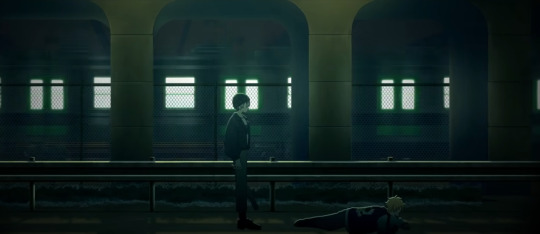
First comes the heavy metal style, and we watch the murder. Keeping in mind the voice drama, and going with the idea that “Mikoto” is the murderer, this calls the desire to link this style of music to him.

But then we get this music, and we get the pleas to look at him more closely, and just... this doesn’t really match the vibe Orekoto gave off, yknow? But, maybe it’s just an act, by him or mikoto. But-- who exactly would this act be for? And how? With every other prisoner, even if they try to put on airs, it feels more like it’s because they themselves buy into those airs, at least a little. It still reflects something genuine in them. With the nature of extractions, it doesn’t seem like it should be possible, for the songs themselves to purposefully look es/the audience in the eye and say “No, no, that isn’t true.”
I've thought about the possibility that this is still Mikoto, though-- and rather than pleading to reconsider that he’s a killer, the possibility came up that he could be.. unaware that he’s part of a system? And begging “It must be a mistake, take a good look at me”, could instead be denial to that fact? Maybe, it’s on the table for me.
Bu t back to the three person theory-- uhhh I’ll refer to this one as ‘Aokoto’ :>
So. Whoever this is, we don’t get to see their eyes the first time this scene comes up, besides the first time they open them. Hard to read from that. But sort of plays into the added theory at the end of this post--
The second time it goes back to this motif-- my girlfriend jus t pointed this out like last night I love her It follows the mirror scene, and there’s...

One-- who’s in the mirror

Two-- who’s head bows

Three...?
The one in the mirror changed expressions far too quickly, and the one closer to us isn’t making that expression; if it were his reflection, his thumb should be reflected too..?
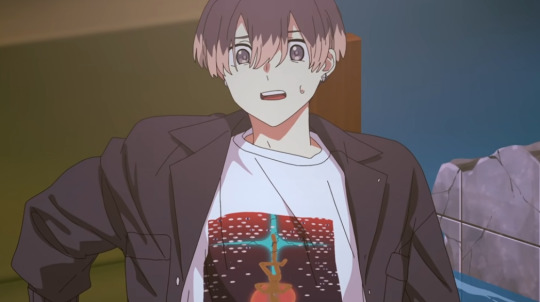
We come back to blue, and he falls back-- This look of horror feels genuine. Again, maybe it could be Mikoto, simply unaware and being confronted with his DID-- Or could be Aokoto, being confronted with everything.

As the water goes red, if we assume it’s blood/representation of the murder, then.... Well, if Mikoto killed someone, and Orekoto was cleaning up the mess, then they both would be pretty well aware, right? So what’s this expression for?
We cut to him in the bath, washing off the blood. An air around him that reads more like Orekoto to me, but I digress-- We go back to blue.
And here.

These eyes feel fake.

I don’t know what exactly it is about it-- his eyes, expression, movement, but here, all I can read as genuine about him is desperation, to sweep it all under the rug, to convince. Maybe it’s Aokoto trying to convince himself. Maybe it’s Mikoto or Orekoto trying to convince you.
Personally, I feel like it’s Mikoto now, but that’s just personal vibes. I think Mikoto puts on the act, loosely mimicking Aokoto’s sweeter presence

then drops it, issuing a sort of warning,
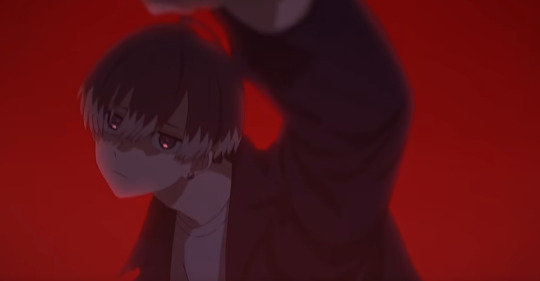
and Orekoto comes in at the very end, telling us that we’re done now.
.
.
.
Maybe. I don’t know. I wish I knew a single thing about tarot cuz that might help.
But, my friends and I have been toying with the idea that Aokoto may have split off right after the murder-- An alter that’s meant to carry no stress at all, giving the body a few moments to just relax... Maybe? but that part’s not based on anything besides. there’s probably a lot of stress wrapped up in this boy.
-- Ah, I’m also leaning toward the idea that it was Aokoto who spoke for the first part of their interrogation with Es-- There could have been an act there too of course, but at times he just sounded... too genuinely confused, scared? It makes one wonder.
#|[.OOC#|[N으 .09#mik09to#((SORRY this got. long.#''rambling'' you say then what am //I// doing orz#l o v e this conversation though gosh thank you#I hope this makes sense? it's so late I'm going to bed now#(〃 ̄︶ ̄)人( ̄︶ ̄〃) !!
3 notes
·
View notes